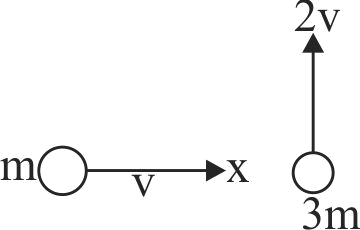355332 A particle of mass \(10\;kg\) moving eastwards with a speed \(5\;m{s^{ - 1}}\) collides with another particle of the same mass moving north-wards with the same speed \(5\;m{s^{ - 1}}\). The two particles coalesce on collision. The new particle of mass \(20\;kg\) will move in the north-east direction with velocity
355332 A particle of mass \(10\;kg\) moving eastwards with a speed \(5\;m{s^{ - 1}}\) collides with another particle of the same mass moving north-wards with the same speed \(5\;m{s^{ - 1}}\). The two particles coalesce on collision. The new particle of mass \(20\;kg\) will move in the north-east direction with velocity
355332 A particle of mass \(10\;kg\) moving eastwards with a speed \(5\;m{s^{ - 1}}\) collides with another particle of the same mass moving north-wards with the same speed \(5\;m{s^{ - 1}}\). The two particles coalesce on collision. The new particle of mass \(20\;kg\) will move in the north-east direction with velocity
355332 A particle of mass \(10\;kg\) moving eastwards with a speed \(5\;m{s^{ - 1}}\) collides with another particle of the same mass moving north-wards with the same speed \(5\;m{s^{ - 1}}\). The two particles coalesce on collision. The new particle of mass \(20\;kg\) will move in the north-east direction with velocity
